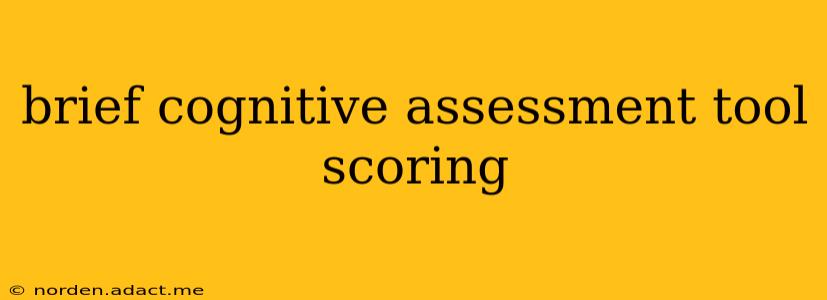Brief cognitive assessment tools are invaluable for quickly screening cognitive function. However, understanding how to accurately score these assessments is crucial for obtaining meaningful results. This guide will delve into the scoring processes, interpreting the results, and the limitations of these tools.
What is a Brief Cognitive Assessment Tool?
Brief cognitive assessment tools are short, standardized tests designed to evaluate various cognitive domains, including memory, attention, language, and executive function. These tools are often used in clinical settings for initial screenings, monitoring cognitive changes over time, or identifying individuals who may require more comprehensive neuropsychological evaluations. Examples include the Mini-Mental State Examination (MMSE), Montreal Cognitive Assessment (MoCA), and Saint Louis University Mental Status Examination (SLUMS).
How are Brief Cognitive Assessment Tools Scored?
The scoring process varies depending on the specific tool used. Each assessment has a detailed manual outlining the administration and scoring procedures. Generally, scoring involves assigning points to correct responses, with a total score reflecting overall cognitive performance. Some assessments use weighted scoring, assigning different point values to different items based on their clinical significance.
Common Scoring Elements:
- Raw Score: The total number of points obtained based on correct responses.
- Standard Score: A converted score that compares the individual's performance to a normative sample, often expressed as a z-score or T-score. This allows for comparison across different age groups and populations.
- Percentile Rank: The percentage of individuals in the normative sample who scored at or below a specific raw score.
H2: What is the difference between raw score and standard score?
A raw score simply represents the number of correctly answered questions or completed tasks. A standard score, however, transforms the raw score into a standardized metric that takes into account factors like age and education level. This allows for more accurate comparisons between individuals and provides a clearer picture of cognitive performance relative to a normative group. Standard scores often fall within a specific range (e.g., a mean of 100 with a standard deviation of 15).
H2: How do I interpret the scores of a brief cognitive assessment?
Interpretation requires careful consideration of several factors:
- The specific assessment used: Each tool has its own scoring system and normative data. Consult the manual for detailed interpretation guidelines.
- Raw score: Compare the obtained raw score to the cut-off scores provided in the manual. Scores below the cut-off often suggest potential cognitive impairment.
- Standard score: Compare the standard score to the normative sample's mean and standard deviation to assess performance relative to the population.
- Contextual information: Consider the individual's age, education, cultural background, and any pre-existing medical conditions. These factors can significantly influence cognitive performance.
Remember: A low score on a brief cognitive assessment does not necessarily indicate a specific diagnosis. It indicates a need for further evaluation by a qualified healthcare professional.
H2: What are the limitations of brief cognitive assessment tools?
While valuable for initial screening, brief cognitive assessment tools have limitations:
- Sensitivity and Specificity: These tools may not be sensitive enough to detect subtle cognitive changes or specific cognitive deficits.
- False Positives and False Negatives: Scores can be influenced by factors such as fatigue, anxiety, and language barriers, leading to false positives or negatives.
- Limited scope: They assess a limited range of cognitive functions and may not provide a comprehensive picture of cognitive abilities.
Conclusion
Brief cognitive assessment tools provide a valuable initial screening of cognitive function. However, accurate scoring and interpretation are essential for obtaining meaningful results. Always consult the specific assessment's manual for detailed scoring instructions and interpretation guidelines. A low score should prompt referral for more comprehensive neuropsychological testing to determine the presence and nature of any cognitive impairment. Remember, these tools are screening instruments, not diagnostic tests. A qualified healthcare professional should always interpret the results in the context of the individual's overall medical history and clinical presentation.
